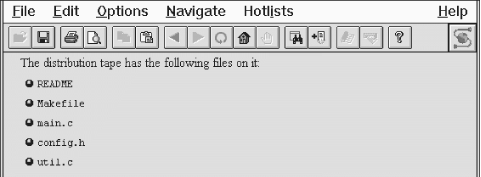
7.7. Directory Lists
The directory list is a specialized form of the unordered list. It has been deprecated in the HTML 4 and XHTML standards. We don't recommend that you use it at all. Section 7.1.1, "The <ul> Tag"
7.7.1. The <dir> Tag (Deprecated)
The designers of HTML originally dedicated the <dir> tag for displaying lists of files. As such, the browser, if it treats <dir> and <ul> differently at all (most don't), expects the various list elements to be quite short, possibly no longer than 20 characters or so. Some browsers display the elements in a multicolumn format and may not use a leading bullet.
As with the unordered list, define directory list items with the <li> tag. When used within a directory list, however, the <li> tag may not contain any block element, including paragraphs, other lists, preformatted text, or forms.
The following example puts the directory tag to its traditional task of presenting a list of filenames:
The distribution tape has the following files on it: <dir> <li><code>README</code></li> <li><code>Makefile</code></li> <li><code>main.c</code></li> <li><code>config.h</code></li> <li><code>util.c</code></li> </dir>
<dir>
- Function:
Define a directory list
- Attributes:
CLASS
ONKEYUP
DIR
ONMOUSEDOWN
ID
ONMOUSEMOVE
LANG
ONMOUSEOUT
ONCLICK
ONMOUSEOVER
ONDBLCLICK
ONMOUSEUP
ONKEYDOWN
STYLE
ONKEYPRESS
TITLE
- End tag:
</dir>; never omitted
- Contains:
list_content
- Used in:
block
Notice that we use the <code> tag to ensure that the filenames would be rendered in an appropriate manner (see Figure 7-9 as rendered by the now ancient Mosaic browser).

Figure 7-9. An example <dir> list
7.7.1.1. The <dir> attributes
The attributes for the <dir> tag are identical to those for <ul> with the same effects.

Copyright © 2002 O'Reilly & Associates. All rights reserved.



